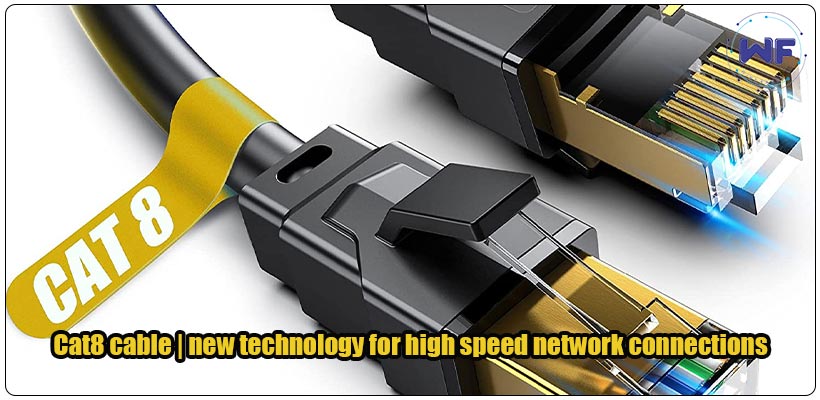Cat8 cable is one of the latest generations of network cables, designed and built to enable data transmission at very high speeds in networks. These cables have advanced design and standards and are capable of transferring data at speeds of up to 25 gigabits per second. In this article, the characteristics, performance and applications of Cat8 cable are reviewed.
Introduction:
Network technology is developing rapidly and requires higher speeds and functions for data transfer. Cat8 cable, as one of the advanced generations of network cables, has been able to provide data transmission at higher speeds by improving features and reducing noise. In this article, the characteristics, performance and applications of Cat8 cable are reviewed.
1. Features of Cat8 cable:
paired pairs:
Cat8 cable has 4 paired pairs of wires that help reduce electromagnetic interference and improve data transmission quality.
Shielding:
Cat8 cable has two layers of foil coating that acts as shielding and prevents interference and external noise.
High frequency support:
This cable supports up to 2000 MHz frequency, which helps to transfer data at higher speeds.
Support for RJ45 connectors:
Cat8 cable uses RJ45 connectors, which are standardized in many networks, and various connectors are available for this type of cable.
2. Performance of Cat8 cable:
– High-speed data transmission: Cat8 cable is capable of transmitting data at speeds of up to 25 Gbps, which is suitable for very complex and high-traffic networks.
– Increasing the signal strength:
This cable enables the transmission of data to longer distances by increasing the signal strength.
– Increasing bandwidth:
Cat8 cable helps to transfer high quality data by supporting high frequencies and increasing bandwidth.
3. Applications of Cat8 cable:
– Data center networks:
Cat8 cable is used to connect servers, routers, switches and network equipment in data centers.
– Industrial communication networks:
This cable is used to connect industrial devices and equipment in industrial communication networks.
– Mobile networks:
Cat8 cable is used to connect equipment and mobile communication stations in telecommunication networks.
Improvements compared to cables of previous generations:
– Increased transmission speed: Cat8 cable is able to transmit data at higher speeds than cables of previous generations such as Cat5e and Cat6. For example, Cat5e cable is capable of transmitting data at speeds of up to 1 Gbps, while Cat8 cables increase this speed to 25 Gbps.
– Increased bandwidth: Cat8 cable supports high frequencies and larger bandwidth, helping to transmit high-quality data without interference.
– Noise reduction: The use of two layers of foil coating and the pairing of wires in the Cat8 cable helps to reduce electromagnetic interference and noise and improves the performance of the cable.
Support for longer distances:
– Cat8 cable is able to transmit data over longer distances than cables of previous generations. This feature is especially important in environments with long distances between network equipment or for long-distance communications.
Use in data center networks:
– Data center networks use Cat8 cable to connect servers, routers, switches and network equipment due to the need to transfer data at high speeds and large bandwidth.
Advantages of using Cat8 cable:
– High speed: Cat8 cable provides the possibility of high speed data transmission, which is suitable for applications and services with large bandwidth and the need to transfer large data.
– Stability and upgradability: Using Cat8 cable creates a stable and upgradable network structure that makes it possible to add devices and upgrade applications in the future.
The advantages of Cat8 cable due to its superior features and performance include:
High speed:
One of the main advantages of Cat8 cable is the ability to transfer data at high speeds. This cable transmits data up to 25 Gbps, which provides much higher speeds than previous generations of network cables (such as Cat5e and Cat6).
Large bandwidth:
Cat8 cable supports high frequencies and large bandwidth, enabling more stable and quality data transmission. This is important for networks that need to transfer large amounts of data, use applications with high bandwidth, and communications that require stability and upgradeability.
Reduction of noise and interference:
Cat8 cable, having two layers of foil coating and paired wires, helps to reduce electromagnetic interference and external noise. This feature improves the quality of data transmission and network performance.
Use over longer distances:
Cat8 cable is able to transmit data over longer distances than cables of previous generations. This feature is especially important in environments with long distances between network equipment or telecommunications.
Use in data center networks:
Cat8 cable is very suitable for data center networks. Due to the need to transfer data at high speeds and large bandwidth, these networks require advanced cables, which Cat8 cable meets these needs.
Upgradability and stability:
using Cat8 cable creates a stable and upgradable network structure. This cable makes it possible to add devices and upgrade programs in the future and makes the network ready to accept future changes and needs.
In general, Cat8 cable, with its superior features and performance, as an advanced solution for network connections with high speeds and bandwidth, is of great importance in upgrading and improving the performance of networks. The use of this cable in data center networks provides industrial communications and applications and services that require high bandwidth and higher speeds.
Conclusion:
As an advanced technology in the field of network cables, Cat8 cable enables data transmission at high speeds and allows networks to upgrade and improve performance and bandwidth. With SFTP features and two layers of foil coating, this cable prevents electromagnetic interference and improves data transmission quality.
However, Cat8 cable requires proper equipment and connectors to use its full capabilities. This cable is suitable for very complex and high-traffic networks and is used for data centers, industrial communication networks and mobile phone networks.
In general, Cat8 cable with its superior features can transfer data with high quality and speed and help networks to upgrade and improve their performance. Since the Cat8 cable is considered a new technology, its use requires engineering reviews and adaptation to the network’s needs so that it can function optimally and bring the desired results.



2 Responses
Hi wirefaren.com,
I was just browsing your website and I came up with a great plan to re-develop your website using the latest technology to generate additional revenue and beat your opponents.
I’m an excellent web developer capable of almost anything you can come up with, and my costs are affordable for nearly everyone.
Kindly share your whatsapp or skype for furhter communication.
Yours Sincerely
Nishant